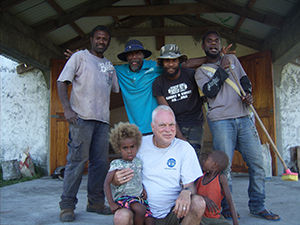Anthropology Colloquia Series: Dr. Lamont Lindstrom
-Event-

Start Date: Oct 18, 2018 - 03:30pm
End Date: Oct 18, 2018 - 04:30pm
Location: Hibben Center 105
On October 18, 2018 at 3:30 pm in Hibben 105, Dr. Lamont Lindstrom will present his talk: "Water, Light, Toilets, and Tourists on Tanna (Vanuatu)"
Abstract:
When I arrived in SE Tanna’s Samaria village in 1978, this small community was off the grid. In years since, government and non-governmental organizations have funded a variety of infrastructural development projects: a truck spur road, sundry water catchment tanks and then a reticulated water system, VIP pit toilets, electric generators and solar arrays, and recently a mobile telephony tower looming atop the neighboring mountain. Villagers were more-or-less committed to this infrastructure, using it or not according to their own interests, and usually they permitted it to decay. Reticulated water supply systems and roads were most problematic in that they, unlike other infrastructure that is incontestably emplaced within a single community, extend across several landowning groups from mountain to shore. Village infrastructure projects frequently created more problems than they solved, exacerbating community discord. VIP toilets proved particularly useless. In recent years, people’s resistance to infrastructure has weakened and they have been induced to accept, sometimes pay for, and look after these systems. Samaria is close to Tanna’s active Iasur volcano, and surrounding communities have gone into the bungalow business as increasing numbers of overseas tourists flood the island. Local entrepreneurs must deal with touristic demand for light, water, and toilets. As everywhere, life on the grid brings certain benefits but also many constraints. Infrastructure binds a community together but creates new cages and drives many wedges.
Lamont Lindstrom, Kendall Professor at the University of Tulsa, has long-term research interests in Vanuatu and other Melanesian countries focused on local knowledge systems and social movements, kava, World War Two ethnohistory, contemporary chiefs and the politics of tradition, cultural policy development, sociolinguistics, urban migration and personhood, and early Pacific photography.
